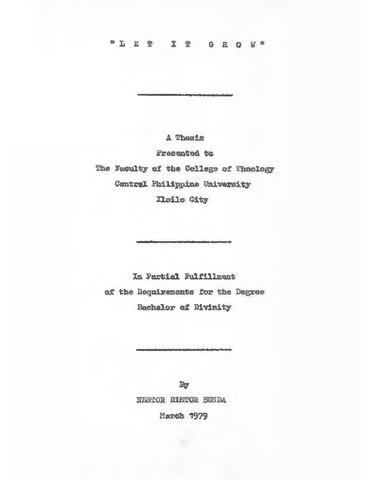Let it grow
| dc.contributor.adviser | Hawkins, Elza M. | |
| dc.contributor.adviser | Hawkins, Lois | |
| dc.contributor.author | Bunda, Nestor D. | |
| dc.date.accessioned | 2022-05-05T00:36:41Z | |
| dc.date.available | 2022-05-05T00:36:41Z | |
| dc.date.issued | 1979 | |
| dc.identifier.citation | Bunda, N. D. (1979). Let it grow (Unpublished thesis). Central Philippine University, Jaro, Iloilo City. | en_US |
| dc.identifier.uri | https://hdl.handle.net/20.500.12852/2046 | |
| dc.description | Introduction | en_US |
| dc.description.abstract | In the local church where I was challenged to be a part of the Christian community, I felt the lack of a close relationship. I did not even know the person beside me during the worship service. In fact many members in my local church do not know that I am enrolled in a seminary. I was baptized without orientation or clear understanding why I must submit to it. I did it only because of "barkada system" (small group who were outcast of the church). I also felt this in my observation of other churches. But my experience pushed me to find some alternatives in order for a structure to be appropriate and flexible for koinonia to take place, and be incarnated. And that is the small group which provides a face-to-face relationship. As Ernsberger affirmed: "If the church members are to be profoundly and intimately united in fellowship with one another and with Christ, the church will need to provide more face-to-face relationship for its members, where they can associate in small meaningful groups in which Christian truth and Christian experience go hand in hand." The Purpose: The purpose of this study is to discover what contributions the small group could offer to the growth of Christian persons in our churches. Delimitations: This study is limited by my own ideas of the small group, and tries to test such ideas with a group composed of eight students in the College of Theology, Central Philippine University, for twenty nine meetings between March 21 and September 29, 1978. My experience in such a group helped me formulate many of my ideas on how to develop small groups in the church and how they could function effectively. Sources of Data: The information used in the chapter dealing with The History of a Group was based upon the "group notes" taken by some members every session and from the Evaluation Sheet used every session and a particular Evaluation Sheet used after the twenty eight meetings. The third basic tool used was the Participant Observation method which reconciles the evaluation of the group members and the 'group notes'. 1. Small group is a basic structure that provides a face-to-face relationship in nurturing each member. 2. Small group is a means for a much freer operation of the Holy Spirit. 3. Small group is an effective means to carry out the mission of Jesus Christ in serving people which is the task of the church. | en_US |
| dc.format.extent | 60 leaves | en_US |
| dc.language.iso | en | en_US |
| dc.subject.ddc | TheoLib Thesis 207.2 B882 | en_US |
| dc.subject.lcsh | Small groups | en_US |
| dc.subject.lcsh | Small groups--Religious aspects--Christianity | en_US |
| dc.subject.lcsh | Christian life | en_US |
| dc.title | Let it grow | en_US |
| dc.type | Thesis | en_US |
| dcterms.accessRights | Not publicly accessible | en_US |
| dc.description.bibliographicalreferences | Includes bibliographical references | en_US |
| dc.contributor.chair | Diel, Domingo J. Jr. | |
| dc.contributor.department | College of Theology | en_US |
| dc.description.degree | Bachelor of Divinity | en_US |
Files in this item
This item appears in the following Collection(s)
-
Theses [9]


